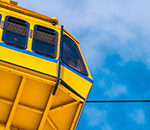There aren’t many things that Nature can cook up that will deter the determination and daring of human beings, but volcanoes certainly come close. Not often do we see close-ups of liquid red rock bubbling through the planet’s fractured surface, but that is exactly what landscape photographer Miles Morgan has created. Working in some of the natural world’s most violent conditions, he captures flowing Earth in its tumultuous explosion to the surface, just off the coast of Hawaii:
Safety is paramount in shoots such as these on the Big Island. The behaviour of lava is unpredictable, subject to unexpected bursts and blasts of molten magma, hot enough to boil the sea around it. If not properly trained and prepared, any photographer who attempts this type of feat is liable to be burned, broken, or possibly carried away by the fast-moving flows of steaming ocean water and lava. In short: you probably shouldn’t try this at home (or elsewhere).
That said, the risk Morgan and his shooting partners, Bruce Omori and Tom Kuali’i of Extreme Exposure, take in this endeavour is a testament to the adventurous spirit of photography. Their fearless challenging of these conditions brings to us, the audience, images of a thing rarely seen and truly awesome. The gorgeous bursts of brilliant oranges, yellows, and reds against the deep, cool blues and purples of the darkened sky and the wild trails of flying brimstone make for incredible images not only from an artistic viewpoint, but from a scientific stance as well.
It’s long been understood that the most arresting photographs are the ones that no one else has the courage or the opportunity to take. This ambitious project takes that notion to its full and logical extreme as it captures the beautiful horror of Nature’s great wrath.
Like This Article?
Don't Miss The Next One!
Join over 100,000 photographers of all experience levels who receive our free photography tips and articles to stay current:







This sucks, I thought this was a how to?
Sorry- the photographer doesn’t provide that information, aside from mentioning in the video that the images are shot just before sunup and just after sundown. The rest would just be guesswork. How to do it, if you really were going to (which we can’t recommend due to the extreme danger) would be, “very carefully, with the help of experienced guides, using a super-tough camera made of magnesium alloy”. Exposures and settings would vary completely based on what kind of effect you were going for.
No How to? Lens used, exposure, best time of day, post processing?
An article discussing How To, with no How To? hummmm….